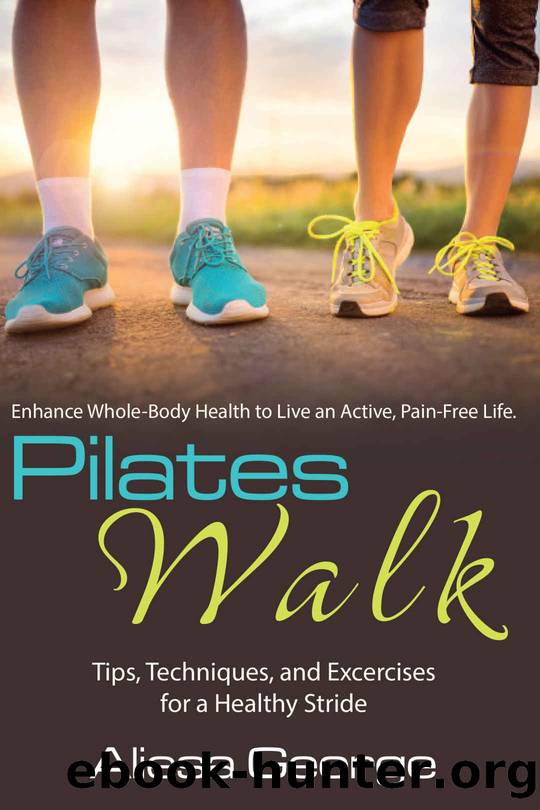Pilates Walk by George Aliesa

Author:George, Aliesa
Language: eng
Format: epub
Tags: Exercise, Pilates, Walking
Publisher: Prime Concepts Group Publishing
Published: 2018-02-15T00:00:00+00:00
The right Hamstrings, right Glute, left side Low Back, left side Lat make up one side of the X, and the left Hamstring, left Glute, right side Low Back, and right Lat make up the other side of the X.
In my experience working with bodies in the health and fitness field for more than 30 years, I have noticed that the average person on the street today tends to walk with the legs more in front of the body than behind them. This makes it much more difficult to find and use the pattern of the Posterior Oblique System (POS) support for a healthy stride. We have to learn how to get the legs to swing farther behind us!
Having a stride where the leg swings more in front of the body with every step means tight hip flexors, over-developed quads, weak hamstrings, an increased risk of Sacro-illiac (SI joint) problems, and low back pain. In part, our lifestyle habits are to blame for this muscle imbalance because we are either sitting in a chair at our computers all day with our hips flexed. And/or, we make poor shoe choices (flip-flops, clogs, and strapless sandals) that shorten our stride and unknowingly cause us to walk without taking our legs completely behind us.
When we stand up and start to walk, our legs tend to stay in front of the body because thatâs what we are used to doing. In addition, poor shoe choices have us taking short little steps because our shoes might fall off. Finally, as we get older, because we havenât really been using our POS, lack of hip strength and balance become an issue, causing us to take smaller and wider steps to avoid falling. This combination of bad movement habits (that you probably donât even realize are happening) are setting you up for a stride that lacks support from your POS. Smaller, shorter steps increase the gap for muscle imbalances, and increase the risk of injury or chronic pain. A longer stride can help keep your muscles stronger, your POS active, and your body in better balance. It becomes a matter of increasing awareness about our daily habits, and finding ways to actively strengthen your Posterior Oblique System.
Walking happens to be one of the most effective and efficient forms of exercise for training your POS, but only if you are walking with good technique! Poor posture and bad movement habits are only going to reinforce what youâve been doing wrong. Your Pilates-Walk⢠training is going to help you find and feel the right muscles working to get that X-pattern of your POS system fired up and working well to support you for walking and everything else you do in life.
Download
This site does not store any files on its server. We only index and link to content provided by other sites. Please contact the content providers to delete copyright contents if any and email us, we'll remove relevant links or contents immediately.
Tools of Titans by Timothy Ferriss(7807)
Bodyweight Strength Training by Jay Cardiello(7672)
Born to Run: by Christopher McDougall(6893)
Inner Engineering: A Yogi's Guide to Joy by Sadhguru(6439)
Asking the Right Questions: A Guide to Critical Thinking by M. Neil Browne & Stuart M. Keeley(5355)
The Fat Loss Plan by Joe Wicks(4619)
Bodyweight Strength Training Anatomy by Bret Contreras(4463)
Yoga Anatomy by Kaminoff Leslie(4100)
Science and Development of Muscle Hypertrophy by Brad Schoenfeld(3968)
Dynamic Alignment Through Imagery by Eric Franklin(3914)
ACSM's Complete Guide to Fitness & Health by ACSM(3819)
The Four-Pack Revolution by Chael Sonnen & Ryan Parsons(3790)
Exercise Technique Manual for Resistance Training by National Strength & Conditioning Association(3784)
Bodyweight Strength Training: 12 Weeks to Build Muscle and Burn Fat by Jay Cardiello(3778)
Yoga Anatomy by Leslie Kaminoff & Amy Matthews(3737)
The Ultimate Bodybuilding Cookbook by Kendall Lou Schmidt(3706)
Yoga Therapy by Mark Stephens(3569)
Nutrition for Sport, Exercise, and Health by Spano Marie & Kruskall Laura & Thomas D. Travis(3556)
Nutrition for Sport, Exercise, and Health by Marie Spano & Laura Kruskall & D. Travis Thomas(3546)
